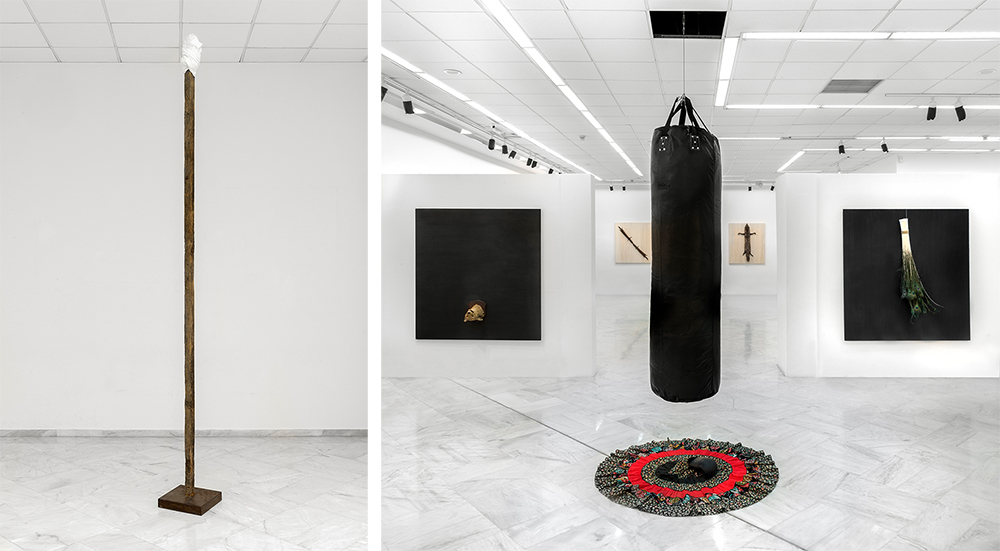ART-PRESENTATION: Lydia Dambassina-Mors
 Lydia Dambassina in her conceptual works is mixing in installations, objets trouvés, photos, texts and videos. Also she has worked as a researcher in psychiatric epidemiology and as an artistic director in film productions. The past ten years, her work is revolving around the economic and moral crisis and the inequalities that are developing geometrically.
Lydia Dambassina in her conceptual works is mixing in installations, objets trouvés, photos, texts and videos. Also she has worked as a researcher in psychiatric epidemiology and as an artistic director in film productions. The past ten years, her work is revolving around the economic and moral crisis and the inequalities that are developing geometrically.
By Dimitris Lempesis
Photo: Lydia Dambasina Archive
Lydia Dambassina’s solo exhibition “Mors” at The Municipal Gallery of Larissa- G.I. Katsigras Museum, takes its name from the personification of death in Roman mythology equivalent to the Greek Thánatos. This is also the title of her most recent body of works that consists entirely of black paintings, on the surface of which various items (the feathers of a peacock, the embalmed head of a wild animal, or a cage with bones) are attached, touching an area of allegories that relate to life and death. Lydia Dambassina says “I use two languages in my work: that of images and that of words” this is clearly shown in her series “Family story” (2007) and “Party’s over – Starts over” (2008-11). That show the share of the personal and public subconscious in every event. The text and the photography in the pictures of Lydia Dambassina are morphologically clearly separated. While each of the two parts function autonomous, their coexistence is a structure (pattern), which gives space to the viewer for something new. In “Party’s over – Starts over” (2008-11), large-scale photos, shot from the same perspective and always in the same space, in front of a white wall, an old wooden table on the first level is the dominating object. Each work consists of two parts: the upper part features the picture in its entirety, while a text -mainly excerpts from the Greek and French daily press- is placed below it. Images alternate in a sequence: a Greek flag folded on a desk next to a copy of the Greek newspaper “Ta Nea” with the headline “All Ways Are Closed”; a knife nailed on a bone (Meanwhile, Greece travels and travels); a plate of grapes (The Grapes of Wrath); a loaf of bread – a reference to the current adversities faced by the arts since governments are cutting cultural funding (Man shall not live on bread alone). Amplifying news fragments into weighty ontological or existential gestures seems an efficient way to deal with all this tragic absurdity. “My images resemble the panorama of an entire life that a person sees marching before him in a split second just before he dies. They are coordinated with deconstruction. Silent images. There is no place for unnecessary feelings. The cold has surrounded me”. The concepts of death, decline and loss, of memory management and the suspension of oblivion, traverse the units of photos picturing discarded mattresses “Mattresses Shall never Disappear” and those depicting the gradual emptying of an urban apartment following the death of its female owner, “Untitled”. In the center of an untitled installation is a boxing bag, giving prominence to the issue of abuse and violence against women. Also on presentation is a video projection of 33 original slides titled “Le Lac”, an expressly experiential and emotional work, which serves as an ode to life, freedom, nature, love and coexistence. Lydia Dambassina was born in 1951 in Thessaloniki. At the age of 15 she moved to Paris to finish school. She studied Psychopathology and Pedagogy and at the School of Fine Arts of Grenoble. Since 1976, Lydia Dambassina has been working with different mediums.
Info: Curator: Yannis Bolis, The Municipal Gallery of Larissa- G.I. Katsigras Museum, 2 G.Papandreou Street, Larissa, Duration: 18/5-16/9/18, Days & Hours: Tue-Fri 10:00-14:00 & 18:00-21:00, Sat-Sun 10:00-14.00, www.katsigrasmuseum.gr & www.lydiadambassina.com







